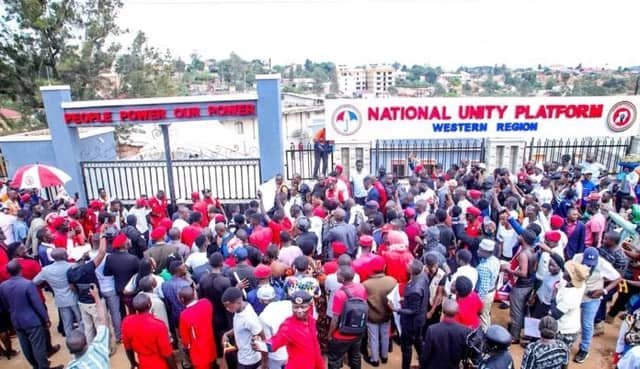Source: UgandaToday
Since 2018, Uganda’s ruling establishment has pursued a steady campaign—through the police, army, and ancillary security organs—of constricting the operations of the the National Unity Platform (NUP). What began as a mix of intimidation, harassment and ad hoc violence has deepened into systematic suppression: abductions, torture, disappearances, deaths, and the destruction of campaign materials. In this piece, we trace that trajectory — from the assassination of Yasin Kawuma in Arua to the recent violent tearing of Kyagulanyi campaign posters in Mbale — and interrogate what this means for Uganda’s fragile political space.
1. The Spark: Kawuma’s Killing and the Arua Affair
On the evening of 13 August 2018, as campaigning for the Arua parliamentary by-election drew to a close, Yasin Kawuma, the driver for MP Robert Kyagulanyi (Bobi Wine), was shot and killed. Authorities insisted it was a “stray bullet” amid clashes, but critics have long argued it was a political assassination. Uganda Radionetwork+3Amnesty International+3Monitor+3
Kawuma’s body was laid to rest at his ancestral home in Buwama, Mpigi, as tens of mourners, many wearing NUP insignia, filled his funeral proceedings. Monitor+1 One year on, commentators noted that an independent inquiry was never conducted, and no person has been held accountable. Monitor+1
That killing unleashed a broader security crackdown. In Arua, dozens of supporters were rounded up, some transported hundreds of kilometres away, questioned, intimidated or tortured. The Guardian+1
It also crystallised the notion among many that the state viewed NUP’s rise as an existential threat, to be countered not through political contestation but via coercion.
2. A Shadow Toll: Names of the Fallen and Harassed
While the Kawuma killing is the most visible flashpoint, it is far from the only fatal or near-fatal act.
Frank Ssenteza
While we are unable to independently verify every detail of his death from publicly available sources, in NUP circulations his name is commonly invoked among those slain or disappeared after openly supporting NUP.
Ritah Nabukenya
Similarly, her name appears in internal party records and among testimonies of bereaved NUP families. (She was ran over by a police patrol car and died.)
Francis Zaake
In the Arua turmoil, MP Francis Zaake was severely injured after being assaulted by security forces. He later pursued medical treatment abroad. Wikipedia He was also charged with treason while still recovering, a move many viewed as punitive and political. Wikipedia
Other implicit casualties
Numerous young NUP activists have reportedly died in suspicious circumstances, or “disappeared” and returned in battered condition. In media and civil society reportage, the count of missing, tortured, or unaccounted-for NUP supporters is described as “uncountable.” The Guardian+2Facebook+2
Because many of these incidents go unreported or are suppressed, the full toll remains opaque. Still, the list above underscores a pattern: overtly political violence increasingly coloring Uganda’s internal security posture.
3. Torture, Incarceration, and the Brutal Enforcement Regime
To complement the list of deaths, it is crucial to document the widespread practices of torture, cruel detention, and extrajudicial abuse that have come to define the state–NUP interface.
3.1 The “Torture Chamber” and the Culture of Abduction
In its 2021 feature, The Guardian described a regime of abductions and torture:
“They used batons, wires and gun barrels to torture us… At least one has been confirmed as having died in custody.”
“Some detainees have had joints or genitals beaten with wires, been burned with cigarettes, or had fingernails torn out.” The Guardian
These practices, though brutal, are not isolated — they implicate multiple security organs, including the police, special forces, the military, and intelligence operatives.
Close-up show of the torn remains of a Kyagulanyi poster, bullets having been fired nearby, under the supervision of OC Mulalira and his team.
3.2 The Case of Eddie (Edward) Ssebuufu aka “Eddie Mutwe”
Probably the most conspicuous recent example is Eddie Mutwe, Bobi Wine’s chief bodyguard.
In April 2025, Mutwe disappeared after being seized near at Mukono from attending a social function. Reuters+2ICTJ+2
His captors reportedly held him in a private home basement and tortured him daily, including by electrocution. Al Jazeera+3Reuters+3Al Jazeera+3
When he reappeared in court, he was in visibly weakened condition. Uganda’s Justice Minister, Norbert Mao, remarked that his injuries and demeanor showed signs of abuse. Al Jazeera+3Reuters+3Uganda Broadcasting Corporation+3
In a social media post, General Muhoozi Kainerugaba admitted to capturing him “like a grasshopper” and claimed to be “teaching him Runyankore.” Al Jazeera+2Reuters+2
He posted a photo of a shirtless, shaved Mutwe with a caption:
“He is in my basement … You are next!” Al Jazeera+1
Subsequent media and civil society alarmed over this brazen admission, pointing to a chilling normalization of state violence. Uganda Broadcasting Corporation+3Al Jazeera+3ICTJ+3
The Mutwe episode is symbolic not only because of its brutality but because it was publicly flaunted — a threat broadcast to the entire NUP base.
3.3 Incarceration, Incommunicado Detention, and Denial of Due Process
Many NUP activists are held without charge, sometimes for weeks or months, often in military or secret detentions. Reuters+3Facebook+3The Guardian+3
They are denied access to lawyers, family, or external medical care. The Guardian+1
Some are subjected to summary courts or quasi-judicial proceedings lacking transparency. The Guardian+1
The state narrative often frames them as criminals or “security threats,” thus attempting to rationalize the repression rather than acknowledge a political crackdown.
In sum, the state has weaponized detention regimes and torture not only as instruments of punishment, but as tools of deterrence — a message to any would-be dissenter.
4. Recent Escalations: Mbale Poster Raids and Nationwide Poster Purges
4.1 Mbale: The Raid by OC Mulalira
Late in September 2025, NUP coordinators in Mbale produced campaign posters and placed them at the party’s Mbale city office. According to accounts, OC Operations Mbale City, Mustafa Mulalira, raided the office, tore the posters, and opened fire — wounding or threatening party members.
NUP’s public grievance is direct:
“Uganda Police, we’ve seen NRM supporters with huge posters of their candidate in different cities and towns — is it a crime if the poster is for the NUP candidate?”
This is not merely symbolic. Poster visibility is a core aspect of political communication, especially in a contest where mass media and public assembly are heavily controlled. The state’s insistence on erasing NUP’s physical footprint — from posters, banners, billboards — is itself a tool of silencing.
4.2 Countrywide Poster Defacements and Removals
Across the country, campaign posters bearing Kyagulanyi’s image or NUP branding have reportedly been defaced, removed, or torn down under cover of darkness or via direct police operations. (NUP supporters have documented many such incidents on social media.)
While an official list is not publicly available, party communication teams and local activists claim dozens of towns — from rural to urban — have experienced targeted purge of NUP paraphernalia.
This is not new: in previous election cycles, parties and activists have documented state-directed poster removal campaigns. What is new is the increasingly aggressive posture — use of live fire, office raids, and personnel intimidation tied directly to security command structures.
5. The Rhetoric of Violence: Threats from State Actors
The physical abuses are only one dimension; equally important is the verbal escalation from powerful figures.
General Muhoozi Kainerugaba
In his social media posts, Muhoozi has not only claimed to physically detain and torture Eddie Mutwe, but has threatened to “castrate” him and released statements like:
“He is in my basement … You are next!” Al Jazeera+3Al Jazeera+3Reuters+3
Such rhetoric is a deeply chilling incitement, carried from a uniformed Office of the Chief of Defence Forces, not an anonymous troll.
The Commander, Defence Forces (CDF)
Muhoozi, as CDF, through his statements assumes direct legitimacy in authorizing coercion. The chilling message: those who align with NUP risk state violence.
Other State Figures and Commands
While we found no verified tweets from the President’s son or CDF beyond the Mutwe incident in our current search, the threat posture is evident in operational actions — the raids, poster destruction, and overt use of security assets in political suppression.
6. Internal Voices of Opposition: Minister Mao and the Condemnation
In the midst of this, the government itself has produced signals of disapproval from within.
Norbert Mao, the Justice Minister (and leader of a smaller opposition-aligned party) issued a statement on 6 May 2025 condemning the torture of Eddie Mutwe. He reaffirmed presumption of innocence and due process, and called on courts to act. Uganda Broadcasting Corporation
His intervention is significant: he occupies a cabinet-level post, yet his remarks implicitly chastise elements of the security apparatus.
Still, Mao’s words remain aspirational — the state machinery’s relentless actions continue. Whether his intervention flags an internal limit to excess or a symbolic escape valve is an open question.
Analysis & Implications
A. The Normalization of State Violence
The sustained use of coercion, torture, and political suppression conveys a deeper shift: violence has become an accepted — even routine — instrument of political control. Where once repression was episodic, today it is institutionalized.
B. Political Messaging Through Silence
By systematically denying space — physical (posters, gatherings), legal (due process), and symbolic (the memory of fallen supporters) — the state attempts to silence NUP not just in action but in memory.
C. The Psychology of Fear
The public nature of abuses — like public tearing of posters or boasting about torture — is a tactic aimed at instilling fear. The message: resistance is not only too costly but dangerous.
D. Constraints Ahead for NUP
NUP’s capacity to mobilize, campaign, and communicate is severely constrained. The party must pivot to safer communication channels, stronger documentation of abuses, and alliances with local media, civil society, and diaspora to maintain visibility.
E. The Fractured State Narrative
When a serving cabinet minister condemns excesses, it reveals cracks in national consensus. The tension between the coercive security arm and the constitutional oversight institutions mirrors Uganda’s unresolved contradictions between authoritarian practices and constitutional form.








